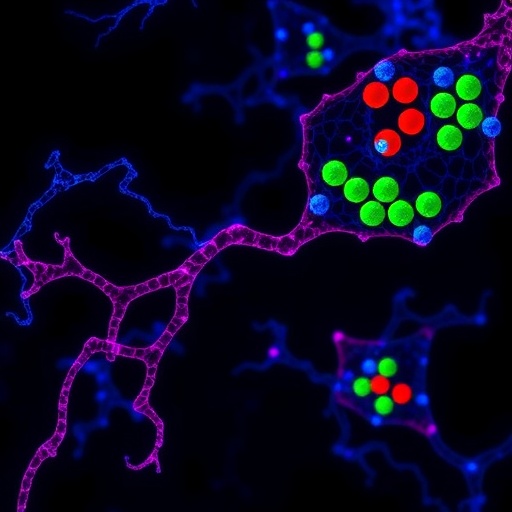In a groundbreaking study published in Nature Neuroscience, researchers have unveiled that the nuclear depletion of the protein TDP-43 in frontotemporal dementia (FTD) and amyotrophic lateral sclerosis (ALS) is linked to widespread alterations in alternative polyadenylation (APA) across the genome. This revelation not only advances our understanding of the molecular pathology underpinning these devastating neurodegenerative diseases but also opens promising avenues for therapeutic interventions targeting RNA processing abnormalities.
TDP-43, a DNA/RNA-binding protein, has long been recognized for its pivotal role in RNA metabolism, including splicing, transport, and stability. In both FTD and ALS, pathological aggregation and mislocalization of TDP-43 occur, marked by its nuclear clearance and cytoplasmic accumulation in neurons. The current study delves deep into the consequences of TDP-43 loss from the nucleus, focusing specifically on how this loss rewires RNA processing mechanisms at the level of polyadenylation site choice.
Alternative polyadenylation is a critical post-transcriptional regulatory mechanism that determines the length and composition of the 3’ untranslated regions (3’ UTRs) of mRNAs. By selecting different polyadenylation sites, cells can modulate mRNA stability, localization, and translation efficiency. Importantly, dysregulation of APA has been implicated in cancer and other diseases but had remained relatively unexplored in neurodegeneration until now.
Utilizing state-of-the-art transcriptome-wide analyses and high-throughput sequencing of poly(A) sites, the research team charted the APA landscape in neuronal cells subjected to nuclear TDP-43 depletion. Their data revealed an extensive rewiring of polyadenylation patterns, with a significant propensity toward usage of distal poly(A) sites, thereby producing mRNAs with elongated 3’ UTRs. Such elongation is known to introduce additional regulatory motifs, including microRNA binding sites and RNA-binding protein interaction domains, which can alter post-transcriptional gene regulation dramatically.
One of the most striking aspects of the findings was the observation that the genes affected by APA changes due to TDP-43 loss are predominantly involved in synaptic function, neuronal projection, and inflammation—pathways heavily implicated in FTD/ALS pathology. This suggests that TDP-43’s role in maintaining APA homeostasis is instrumental to neuronal health and that its perturbation contributes directly to the neurodegenerative cascade.
Furthermore, the study illuminated potential feedback loops by which APA alterations themselves affect RNA-binding proteins, including those interacting with TDP-43. This network effect could amplify RNA misprocessing and exacerbate disease progression. These insights provide a nuanced framework to understand how molecular dysfunction translates into cellular vulnerability and widespread neurodegeneration.
Intriguingly, the investigation extended to patient-derived tissues, where the APA signatures observed in vitro were recapitulated in FTD and ALS brain samples. This concordance underscores the clinical relevance of TDP-43-mediated APA dysregulation and highlights its potential utility as a biomarker for disease diagnosis or progression monitoring.
The mechanistic insights gleaned from this work underscore the versatility of TDP-43 as a guardian of RNA integrity. Beyond its known role in splicing repression, TDP-43 appears integral to the orchestration of alternative polyadenylation machinery. The depletion of nuclear TDP-43 seemingly dismantles this regulatory scaffold, skewing polyadenylation landscapes toward pathogenic states.
In addition to molecular characterization, the authors embarked on probing whether restoration of TDP-43 nuclear localization or direct modulation of APA patterns could ameliorate pathogenic phenotypes. Preliminary interventions in cellular models hint that correcting APA imbalances can partially rescue neuronal dysfunction, spotlighting novel therapeutic strategies that may complement existing anti-aggregation approaches.
Another fascinating dimension of this research is the potential crosstalk between TDP-43 loss and other RNA processing disruptions observed in FTD/ALS, such as splicing abnormalities and altered RNA stability. The integration of these RNA-centric defects possibly contributes to the heterogeneity and complexity that characterizes these neurodegenerative disorders.
Technologically, the study employed innovative long-read sequencing combined with 3’ end RNA sequencing to precisely map polyadenylation sites and quantify isoform abundance. This methodological advance provided unprecedented resolution to capture the nuanced changes instigated by TDP-43 loss, setting a new standard for future explorations of post-transcriptional regulation in neurological disease contexts.
Beyond basic science, these findings bear implications for therapeutic development pipelines. Targeting APA dysregulation could herald a new class of RNA-based interventions, such as antisense oligonucleotides or small molecules that modulate cleavage and polyadenylation specificity. With neurodegenerative disorders notoriously difficult to treat, any leverage point on the RNA processing axis is invaluable.
Critically, this research also prompts a reevaluation of the pathological roles of RNA-binding proteins beyond their classical functions. TDP-43’s multifaceted involvement in RNA metabolism expands our conceptual framework and suggests that combinatorial targeting of RNA pathways might be necessary for effective disease modification.
The study’s contributions extend toward a holistic understanding of the RNA regulatory network’s fragility in neurodegeneration. It demonstrates that nuclear proteins like TDP-43 act not only as static guardians but as dynamic modulators of RNA fate, whose disruption cascades through cellular systems, amplifying damage.
Echoing the growing appreciation of RNA biology’s centrality in neurodegenerative disease, this work establishes alternative polyadenylation as a pivotal node affected by TDP-43 pathology. It offers fresh perspectives and a robust dataset that will fuel future inquiries aiming to untangle the complex molecular pathogenesis of FTD and ALS.
In sum, the identification of widespread APA changes induced by TDP-43 nuclear loss reshapes our understanding of the molecular underpinnings driving FTD and ALS. While many challenges remain, including translation to therapies and in vivo validation, this study charts an exciting trajectory for neurodegeneration research centered on RNA dynamics.
As the scientific community presses onward, these insights highlight the profound ripple effect a single protein’s nuclear mislocalization can impart, influencing RNA landscapes and neuronal health. This research not only deepens our molecular understanding but also energizes the search for innovative, RNA-targeted treatments that may ultimately alleviate the burden of devastating neurodegenerative conditions.
Subject of Research: The molecular consequences of TDP-43 nuclear loss on alternative polyadenylation patterns in frontotemporal dementia and amyotrophic lateral sclerosis.
Article Title: TDP-43 nuclear loss in FTD/ALS causes widespread alternative polyadenylation changes.
Article References:
Zeng, Y., Lovchykova, A., Akiyama, T. et al. TDP-43 nuclear loss in FTD/ALS causes widespread alternative polyadenylation changes. Nat Neurosci (2025). https://doi.org/10.1038/s41593-025-02049-3
Image Credits: AI Generated




